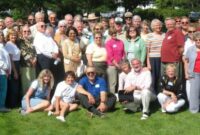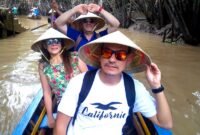Day trips for senior citizens offer a wonderful opportunity to explore new places, engage in enriching activities, and enjoy quality time with friends or family. This guide delves into the essential aspects of planning memorable and accessible day trips, ensuring a safe, enjoyable, and enriching experience for senior travelers. We’ll cover everything from choosing the right destinations and transportation to budgeting effectively and prioritizing health and safety.
From exploring historical landmarks and serene nature trails to attending cultural events and indulging in delightful culinary experiences, the possibilities are vast. We’ll provide practical advice, insightful tips, and sample itineraries to help you craft the perfect day trip tailored to the specific needs and preferences of senior citizens.
Transportation Considerations
Planning transportation for a senior citizen’s day trip requires careful consideration of their physical abilities, comfort levels, and the trip’s destination. Choosing the right mode of transport can significantly impact the overall enjoyment and safety of the experience. Several options exist, each with its own advantages and disadvantages.
Choosing the best transportation method depends on several factors, including the senior’s mobility, the distance to the destination, the trip’s budget, and the availability of transportation options in the area. Careful consideration of these factors ensures a smooth and enjoyable day trip.
Public Transportation Options
Public transportation, such as buses and trains, offers a cost-effective way to travel for seniors, especially for shorter distances within a city or town. Many public transport systems offer senior discounts, making it an attractive option. However, navigating public transport can be challenging for some seniors, especially those with mobility issues. Waiting times at bus stops or train stations can also be uncomfortable, particularly in inclement weather. Accessibility features, such as ramps and elevators, may not always be available or reliable on all routes. For example, a senior with limited mobility might find navigating a busy city bus challenging during peak hours.
Private Car Services
Private car services, including ride-sharing apps and taxi services, offer door-to-door service and greater convenience. This is particularly beneficial for seniors with mobility issues or those traveling to locations not easily accessible by public transport. However, private car services can be more expensive than public transport. Additionally, ensuring the driver’s understanding of senior needs and potential safety concerns, such as securing wheelchairs or providing extra assistance, is crucial. For instance, a pre-booked taxi service could provide a smoother experience than relying on ride-sharing apps, where driver experience can vary.
Organized Group Tours
Organized group tours provide a comprehensive and often stress-free travel experience. Transportation is typically included, usually via a comfortable coach bus equipped with features suitable for seniors. These tours often include planned stops and itineraries, reducing the need for independent navigation. However, group tours may be less flexible than other options and might not cater to individual preferences or specific needs. The cost can also be higher than using public transport or private car services. For example, a guided tour of a historical site might include convenient transportation, entrance fees, and a knowledgeable guide, providing a more complete experience than independent travel.
Safety Tips for Seniors Using Different Transportation Modes
Before outlining safety tips, it’s crucial to emphasize that prioritizing safety is paramount when planning and executing a day trip for seniors. Careful planning and preparation can significantly mitigate risks and ensure a safe and enjoyable experience.
- Public Transportation: Inform a friend or family member of your travel plans, including routes and estimated arrival times. Avoid traveling alone late at night. Use well-lit and populated areas when waiting for transportation. Be aware of your surroundings and belongings.
- Private Car Services: Verify the driver’s identity and vehicle information before entering the car. Share your trip details with a contact person. Use reputable services and always choose licensed drivers. Ensure the car is equipped with appropriate safety features.
- Organized Group Tours: Choose a reputable tour operator with experience in catering to seniors. Familiarize yourself with the tour itinerary and emergency contact information. Inform a contact person of your travel plans. Pay attention to the tour guide’s instructions and safety announcements.
Accessibility and Inclusivity
Planning day trips for senior citizens requires careful consideration of accessibility and inclusivity to ensure a positive and enjoyable experience for everyone. Failing to account for diverse mobility levels and health conditions can significantly impact participation and enjoyment. This section details key considerations for creating inclusive and accessible day trips.
Accessibility considerations for senior citizens are multifaceted, encompassing physical access, sensory considerations, and the overall design of the itinerary. It’s crucial to remember that the senior population is diverse, with varying degrees of mobility, cognitive abilities, and health needs. Therefore, a flexible and adaptable approach is essential.
Accessible Attraction Selection
Choosing accessible attractions is paramount. This involves selecting venues with features such as ramps, elevators, wide doorways, accessible restrooms, and designated seating areas. Examples of accessible attractions include many well-maintained national parks offering paved trails and accessible visitor centers (e.g., some sections of Yosemite National Park), botanical gardens with accessible pathways and benches (like the New York Botanical Garden), and museums with wheelchair-accessible entrances and ramps (such as the Smithsonian National Museum of Natural History). When researching potential venues, always check their website for accessibility information or contact them directly to inquire about specific features and services.
Itinerary Design for Diverse Abilities
Designing an itinerary that accommodates diverse physical abilities and potential health concerns requires careful planning and flexibility. The pace of the trip should be relaxed, with ample time for rest stops and breaks. Consider incorporating options for different activity levels, allowing participants to choose activities that suit their capabilities. For instance, a walking tour could be supplemented with a bus tour option for those with limited mobility. Furthermore, the itinerary should incorporate readily available accessible restrooms and seating areas throughout the day. Including contingency plans for unexpected health issues, such as having emergency contact information readily available and pre-planning transportation to nearby medical facilities, is crucial. A well-designed itinerary prioritizes comfort and safety, ensuring all participants can fully enjoy the experience.
Addressing Sensory Considerations
Beyond physical accessibility, sensory considerations are equally important. Some seniors may have visual or auditory impairments, requiring modifications to the itinerary and communication strategies. Providing large-print materials, audio descriptions, and clear verbal instructions can significantly enhance the experience for individuals with sensory impairments. Consider the noise levels of venues and plan for quieter spaces or breaks for those who are sensitive to sound. Appropriate lighting levels should also be considered to ensure comfortable viewing for all participants. Furthermore, providing opportunities for quiet reflection or rest throughout the day can be particularly beneficial for those with sensory sensitivities.
Sample Itinerary Creation
Creating a well-structured itinerary is crucial for a successful and enjoyable day trip for senior citizens. The itinerary needs to balance engaging activities with ample opportunities for rest and relaxation, catering to varying energy levels and potential mobility limitations. This sample itinerary prioritizes accessibility, comfort, and a relaxed pace.
A Sample Day Trip Itinerary for Senior Citizens: Coastal Charm
This itinerary focuses on a coastal town, offering a blend of scenic views, gentle activities, and opportunities for relaxation. It’s designed to be adaptable to individual needs and preferences.
| Time | Activity | Location | Notes |
|---|---|---|---|
| 9:00 AM – 9:30 AM | Arrival and Welcome Coffee/Tea | Coastal Town Community Center | Light refreshments and a chance to socialize. Restrooms available. |
| 9:30 AM – 10:30 AM | Scenic Coastal Walk | Designated, paved coastal path | Gentle, flat walk offering stunning ocean views. Benches provided at regular intervals for rest. Pace adjusted to the group’s ability. |
| 10:30 AM – 11:00 AM | Rest Break | Scenic overlook with benches | Opportunity to relax, enjoy the view, and take photos. Refreshments available. |
| 11:00 AM – 12:00 PM | Visit to a Local Art Gallery/Museum | Coastal Town Art Gallery/Museum (wheelchair accessible) | Explore local art and culture at a leisurely pace. Restrooms available. The gallery offers seating areas. |
| 12:00 PM – 1:00 PM | Lunch | Restaurant with outdoor seating (wheelchair accessible) | Relaxed lunch with options for various dietary needs. |
| 1:00 PM – 2:00 PM | Free Time/Optional Activity | Coastal Town Shops/Park | Opportunity for souvenir shopping, relaxing in the park, or simply resting. Individuals can choose activities based on their energy levels. |
| 2:00 PM – 2:30 PM | Afternoon Tea/Coffee | Café with comfortable seating | Relaxing break with light refreshments. |
| 2:30 PM – 3:30 PM | Return Transportation | Bus/Van | Comfortable transportation back to the designated drop-off point. |
Concluding Remarks
Planning a day trip for senior citizens requires careful consideration of various factors, but the rewards are immeasurable. By prioritizing accessibility, safety, and enjoyment, you can create unforgettable experiences that promote social connection, cognitive stimulation, and overall well-being. Remember that the goal is to foster a sense of adventure and fulfillment, allowing seniors to actively participate in enriching activities while enjoying the company of loved ones or new friends. With thoughtful planning and a focus on inclusivity, day trips can become a cherished part of a senior’s life.




